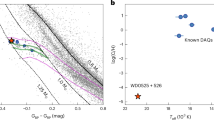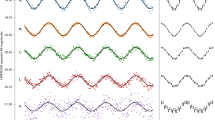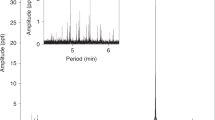Abstract
Hypervelocity white dwarfs (HVWDs) are stellar remnants moving at speeds that exceed the Milky Way’s escape velocity. The origins of the fastest HVWDs are enigmatic, with proposed formation scenarios struggling to explain both their extreme velocities and observed properties. Here we report a three-dimensional hydrodynamic simulation of a merger between two hybrid helium–carbon–oxygen WDs (with masses of 0.69 M⊙ and 0.62 M⊙, where M⊙ is the mass of the Sun). We find that the merger leads to a partial disruption of the secondary WD, coupled with a double-detonation explosion of the primary WD. This launches the remnant core of the secondary WD at a speed of 2,000 km s−1, consistent with observed HVWDs. The low mass of the ejected remnant and heating from the primary WD’s ejecta explain the observed luminosities and temperatures of hot HVWDs, which are otherwise difficult to reconcile with previous models (such as the dynamically driven double-degenerate double-detonation scenario). This discovery establishes a new formation channel for HVWDs and points to a pathway for producing peculiar type Ia supernovae and faint explosive transients.
This is a preview of subscription content, access via your institution
Access options
Access Nature and 54 other Nature Portfolio journals
Get Nature+, our best-value online-access subscription
$32.99 / 30 days
cancel any time
Subscribe to this journal
Receive 12 digital issues and online access to articles
$119.00 per year
only $9.92 per issue
Buy this article
- Purchase on SpringerLink
- Instant access to full article PDF
Prices may be subject to local taxes which are calculated during checkout



Similar content being viewed by others
Data availability
The MESA input files for relaxation, heating and evolution are available via Zenodo at https://doi.org/10.5281/zenodo.15700950 (ref. 46). All data underlying this research that are not in the Zenodo repository (particularly the many hydrodynamical simulation snapshots that are too large) are available upon reasonable request from the corresponding authors. Source data are provided with this paper.
References
Jordan, G. C., Perets, H. B., Fisher, R. T. & van Rossum, D. R. Failed-detonation supernovae: subluminous low-velocity Ia supernovae and their kicked remnant white dwarfs with iron-rich cores. Astrophys. J. Lett. 761, L23 (2012).
Vennes, S. et al. An unusual white dwarf star may be a surviving remnant of a subluminous type Ia supernova. Science 357, 680–683 (2017).
Shen, K. J. et al. Three hypervelocity white dwarfs in Gaia DR2: evidence for dynamically driven double-degenerate double-detonation type Ia supernovae. Astrophys. J. 865, 15 (2018).
El-Badry, K. et al. The fastest stars in the Galaxy. Open J. Astrophys. 6, 28 (2023).
Raddi, R. et al. Further insight on the hypervelocity white dwarf, LP 40-365 (GD 492): a nearby emissary from a single-degenerate type Ia supernova. Astrophys. J. 858, 3 (2018).
Raddi, R. et al. Partly burnt runaway stellar remnants from peculiar thermonuclear supernovae. Mon. Not. R. Astron. Soc. 489, 1489–1508 (2019).
Gaia Collaboration et al. Gaia Data Release 2. Summary of the contents and survey properties. Astron. Astrophys. 616, A1 (2018).
Gaia Collaborationet al. Gaia Data Release 3. Summary of the content and survey properties. Astron. Astrophys. 674, A1 (2023).
Igoshev, A. P., Perets, H. & Hallakoun, N. Hyper-runaway and hypervelocity white dwarf candidates in Gaia Data Release 3: possible remnants from Ia/Iax supernova explosions or dynamical encounters. Mon. Not. R. Astron. Soc. 518, 6223–6237 (2023).
Scholz, R. D. Hypervelocity star candidates from Gaia DR2 and DR3 proper motions and parallaxes. Astron. Astrophys. 685, A162 (2024).
Bhat, A. et al. Supernova shocks cannot explain the inflated state of hypervelocity runaways from white dwarf binaries. Astron. Astrophys. 693, A114 (2025).
Wong, T. L. S., White, C. J. & Bildsten, L. Shocking and mass loss of compact donor stars in type Ia supernovae. Astrophys. J. 973, 65 (2024).
Hansen, B. M. S. Type Ia supernovae and high-velocity white dwarfs. Astrophys. J. 582, 915–918 (2003).
Blaauw, A. On the origin of the O- and B-type stars with high velocities (the “run-away” stars), and some related problems. Bull. Astron. Inst. Neth. 15, 265 (1961).
Guillochon, J., Dan, M., Ramirez-Ruiz, E. & Rosswog, S. Surface detonations in double degenerate binary systems triggered by accretion stream instabilities. Astrophys. J. Lett. 709, L64–L69 (2010).
Pakmor, R., Kromer, M., Taubenberger, S. & Springel, V. Helium-ignited violent mergers as a unified model for normal and rapidly declining type Ia supernovae. Astrophys. J. Lett. 770, L8 (2013).
Sato, Y. et al. A systematic study of carbon-oxygen white dwarf mergers: mass combinations for type Ia supernovae. Astrophys. J. 807, 105 (2015).
Iben Jr, I. & Tutukov, A. V. On the evolution of close binaries with components of initial mass between 3 solar masses and 12 solar masses. Astrophys. J. Suppl. Ser. 58, 661–710 (1985).
Iben Jr, I., Nomoto, K. I., Tornambe, A. & Tutukov, A. V. On interacting helium star–white dwarf pairs as supernova precursors. Astrophys. J. 317, 717 (1987).
Bauer, E. B., Chandra, V., Shen, K. J. & Hermes, J. J. Masses of white dwarf binary companions to type Ia supernovae measured from runaway velocities. Astrophys. J. Lett. 923, L34 (2021).
Bauer, E. B., White, C. J. & Bildsten, L. Remnants of subdwarf helium donor stars ejected from close binaries with thermonuclear supernovae. Astrophys. J. 887, 68 (2019).
Shields, J. V. et al. No surviving sn Ia companion in SNR 0509-67.5: stellar population characterization and comparison to models. Astrophys. J. Lett. 950, L10 (2023).
Tanikawa, A., Nomoto, K., Nakasato, N. & Maeda, K. Double-detonation models for Type Ia Supernovae: trigger of detonation in companion white dwarfs and signatures of companions’ stripped-off materials. Astrophys. J. 885, 103 (2019).
Pakmor, R., Zenati, Y., Perets, H. B. & Toonen, S. Thermonuclear explosion of a massive hybrid HeCO white dwarf triggered by a He detonation on a companion. Mon. Not. R. Astron. Soc. 503, 4734–4747 (2021).
Pakmor, R. et al. On the fate of the secondary white dwarf in double-degenerate double-detonation type Ia supernovae. Mon. Not. R. Astron. Soc. 517, 5260–5271 (2022).
Boos, S. J., Townsley, D. M. & Shen, K. J. Type Ia supernovae can arise from the detonations of both stars in a double degenerate binary. Astrophys. J. 972, 200 (2024).
Pollin, J. M. et al. On the fate of the secondary white dwarf in double-degenerate double-detonation type Ia supernovae - II. 3D synthetic observables. Mon. Not. R. Astron. Soc. 533, 3036–3052 (2024).
Iben Jr, I. & Tutukov, A. V. On the evolution of close binaries with components of initial mass between 3 M⊙ and 12 M⊙. Astrophys. J. Suppl. Ser. 58, 661–710 (1985).
Zenati, Y., Toonen, S. & Perets, H. B. Formation and evolution of hybrid He-CO white dwarfs and their properties. Mon. Not. R. Astron. Soc. 482, 1135–1142 (2019).
Springel, V. E pur si muove: Galilean-invariant cosmological hydrodynamical simulations on a moving mesh. Mon. Not. R. Astron. Soc. 401, 791–851 (2010).
Waldman, R. et al. Helium shell detonations on low-mass white dwarfs as a possible explanation for SN 2005E. Astrophys. J. 738, 21 (2011).
Sim, S. A. et al. 2D simulations of the double-detonation model for thermonuclear transients from low-mass carbon-oxygen white dwarfs. Mon. Not. R. Astron. Soc. 420, 3003–3016 (2012).
Zenati, Y. et al. The origins of calcium-rich supernovae from disruptions of CO white dwarfs by hybrid He-CO white dwarfs. Astrophys. J. 944, 22 (2023).
Taubenberger, S. in The Extremes of Thermonuclear Supernovae (eds Alsabti, A. W. & Murdin, P.) Handbook of Supernovae 317 (Springer, 2017).
Perets, H. B. et al. A faint type of supernova from a white dwarf with a helium-rich companion. Nature 465, 322–325 (2010).
Paxton, B. et al. Modules for Experiments in Stellar Astrophysics (MESA). Astrophys. J. Suppl. Ser. 192, 3 (2011).
Werner, K., El-Badry, K., Gänsicke, B. T. & Shen, K. J. Ultraviolet spectroscopy of the supernova Ia hypervelocity runaway white dwarf J0927-6335. Astron. Astrophys. 689, L6 (2024).
Perets, H. B., Zenati, Y., Toonen, S. & Bobrick, A. Normal type Ia supernovae from disruptions of hybrid He-CO white-dwarfs by CO white-dwarfs. Preprint at https://arxiv.org/abs/1910.07532 (2019).
Zenati, Y., Toonen, S. & Perets, H. B. Formation and evolution of hybrid He-CO white dwarfs and their properties. Mon. Not. R. Astron. Soc. 482, 1135–1142 (2018).
Zenati, Y., Perets, H. B. & Toonen, S. Neutron star-white dwarf mergers: early evolution, physical properties, and outcomes. Mon. Not. R. Astron. Soc. 486, 1805–1813 (2019).
Pakmor, R., Bauer, A. & Springel, V. Magnetohydrodynamics on an unstructured moving grid. Mon. Not. R. Astron. Soc. 418, 1392–1401 (2011).
Zhu, C., Pakmor, R., van Kerkwijk, M. H. & Chang, P. Magnetized moving mesh merger of a carbon-oxygen white dwarf binary. Astrophys. J. Lett. 806, L1 (2015).
Weinberger, R., Springel, V. & Pakmor, R. The AREPO public code release. Astrophys. J. Suppl. Ser. 248, 32 (2020).
Paxton, B. et al. Modules for Experiments in Stellar Astrophysics (MESA): planets, oscillations, rotation, and massive stars. Astrophys. J. Suppl. Ser. 208, 4 (2013).
Paxton, B. et al. Modules for Experiments in Stellar Astrophysics (MESA): pulsating variable stars, rotation, convective boundaries, and energy conservation. Astrophys. J. Suppl. Ser. 243, 10 (2019).
Bhat, A. MESA files for origins of the fastest stars from merger-disruption of he-co white dwarfs. Zenodo https://doi.org/10.5281/zenodo.15700950 (2025).
Pakmor, R. et al. Improving the convergence properties of the moving-mesh code AREPO. Mon. Not. R. Astron. Soc. 455, 1134–1143 (2016).
Jermyn, A. S. et al. Modules for Experiments in Stellar Astrophysics (MESA): time-dependent convection, energy conservation, automatic differentiation, and infrastructure. Astrophys. J. Suppl. Ser. 265, 15 (2023).
Hunter, J. D. Matplotlib: a 2D graphics environment. Comput. Sci. Eng. 9, 90–95 (2007).
Harris, C. R. et al. Array programming with NumPy. Nature 585, 357–362 (2020).
Virtanen, P. et al. SciPy 1.0: fundamental algorithms for scientific computing in Python. Nat. Methods 17, 261–272 (2020).
Acknowledgements
H.B.P. acknowledges support for this project from the European Union’s Horizon 2020 research and innovation programme under grant agreement number 865932-ERC-SNeX. H.G. acknowledges support for the project from the Council for Higher Education of Israel. A.B. was supported by the Deutsche Forschungsgemeinschaft (DFG) through grant number GE2506/18-1 and by the Kavli Summer Program, which took place at MPA in Garching in July 2023 and was supported by the Kavli Foundation. We thank E. Bauer and R. Fisher for their valuable comments and discussions.
Author information
Authors and Affiliations
Contributions
H.G. led the key research, ran the hydrodynamical simulations and analysed the results. H.B.P. initiated and supervised the project, suggested the main ideas, analysed the results and wrote the main parts of the paper. A.B. ran the long-term WD evolution modelling and analysis. R.P. assisted with running the hydrodynamical simulations. All authors contributed to writing the paper, making the figures and reviewing the manuscript.
Corresponding authors
Ethics declarations
Competing interests
The authors declare no competing interests.
Peer review
Peer review information
Nature Astronomy thanks the anonymous reviewers for their contribution to the peer review of this work.
Additional information
Publisher’s note Springer Nature remains neutral with regard to jurisdictional claims in published maps and institutional affiliations.
Supplementary information
Supplementary information
Supplementary Figs. 1–3, Tables 1–3 and Sections 2.1–2.6.
Supplementary Video 1
Simulation video. Showing slices of the different densities and temperature and presenting the beginning of the mass transfer, the disruption of the secondary during the interaction, the double detonation and the ejection of the HVWD.
Source data
Source Data Fig. 2
Full data behind Fig. 2.
Rights and permissions
Springer Nature or its licensor (e.g. a society or other partner) holds exclusive rights to this article under a publishing agreement with the author(s) or other rightsholder(s); author self-archiving of the accepted manuscript version of this article is solely governed by the terms of such publishing agreement and applicable law.
About this article
Cite this article
Glanz, H., Perets, H.B., Bhat, A. et al. The origin of hypervelocity white dwarfs in the merger disruption of He–C–O white dwarfs. Nat Astron (2025). https://doi.org/10.1038/s41550-025-02633-4
Received:
Accepted:
Published:
DOI: https://doi.org/10.1038/s41550-025-02633-4



